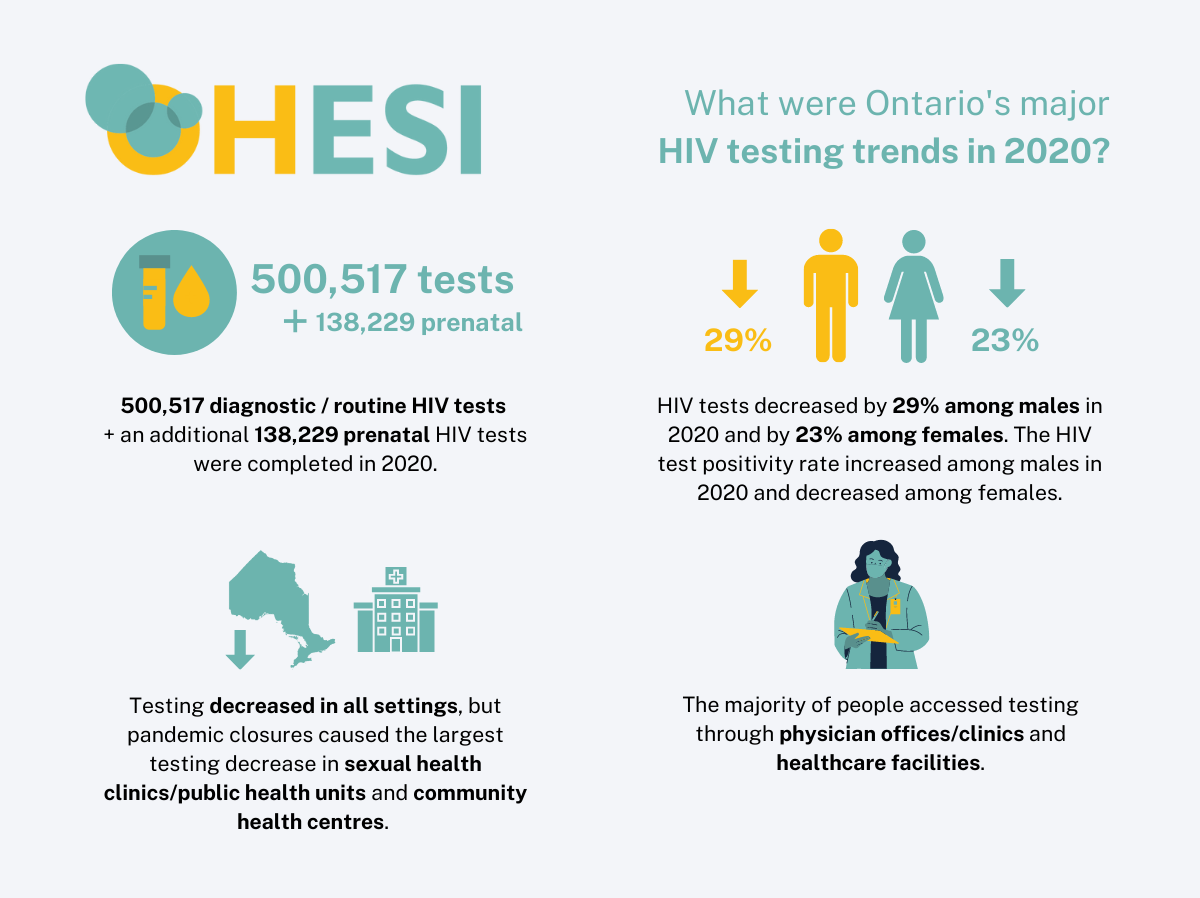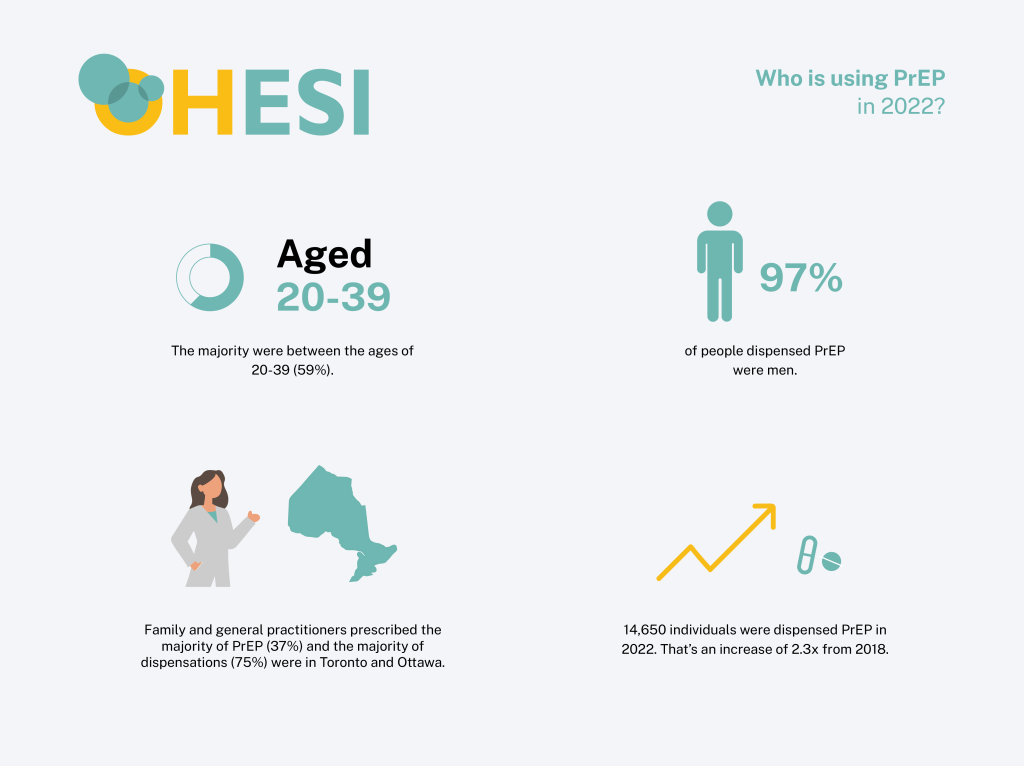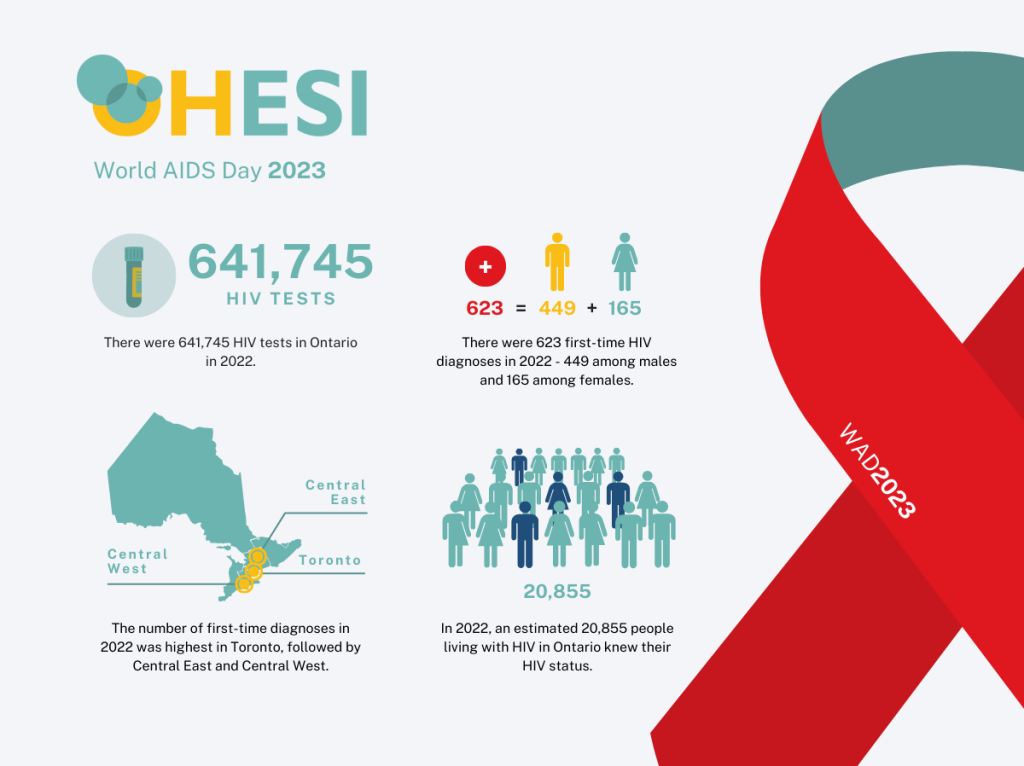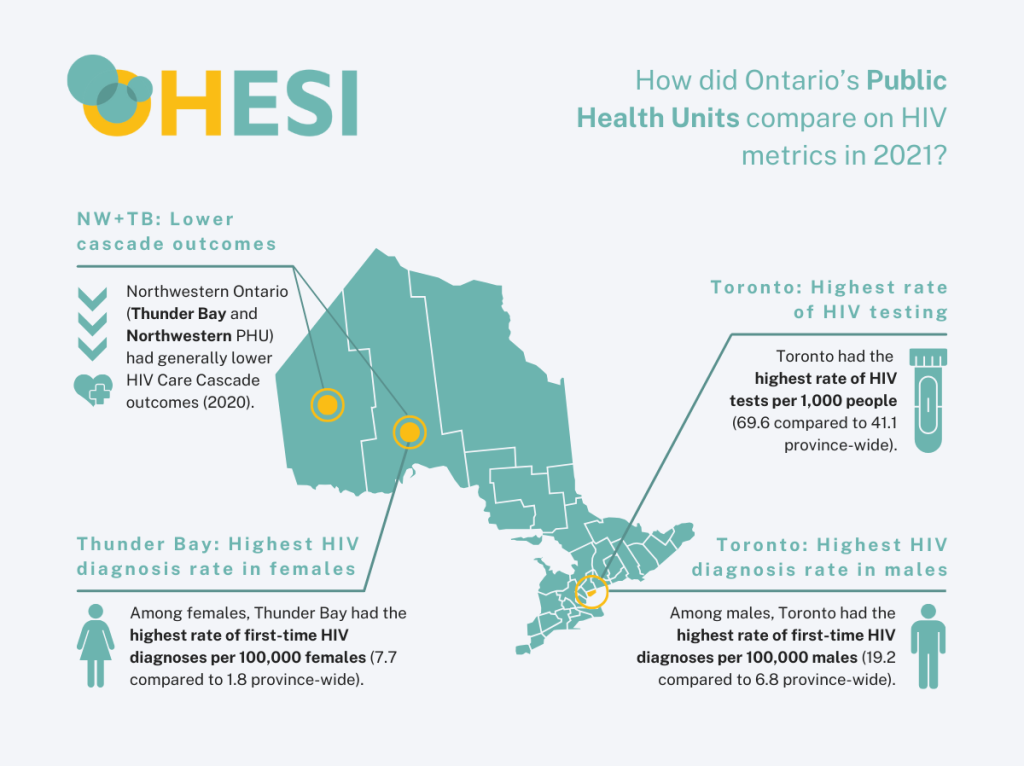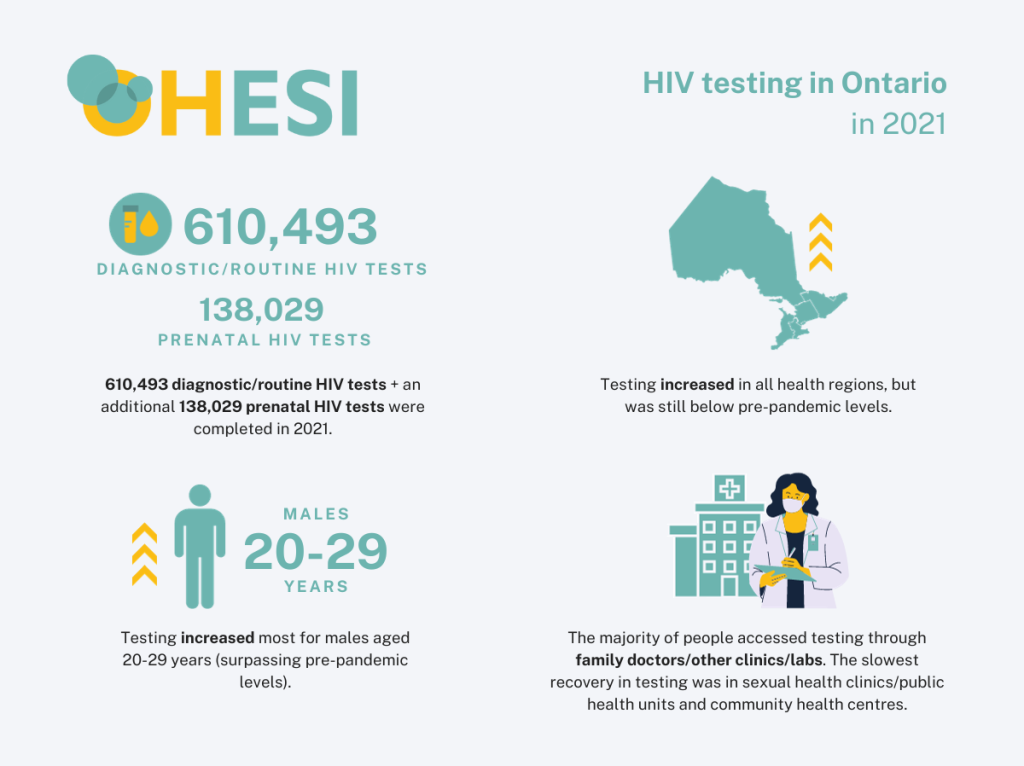Jun 13th, 2022
New report on HIV Tests in Ontario 2020
A robust HIV testing program ensures individuals at risk can be tested regularly, linking people who test positive to care and people who test negative to prevention services. Understanding trends in HIV testing can help Ontario measure the success of its HIV testing initiatives.
The Ontario HIV Epidemiology and Surveillance Initiative (OHESI) is pleased to announce a new report: HIV tests in Ontario, 2020. It describes trends in HIV testing in Ontario over the past decade (2011-2020), with a focus on the more recent impacts of the COVID-19 pandemic.
Key findings from the 2020 HIV Tests in Ontario Report
The COVID-19 pandemic, which began in 2020, disrupted access to health services in Ontario, including HIV testing. OHESI previously discussed the impacts of the pandemic in our previous blog post: Impact of COVID-19 Pandemic on HIV testing and diagnosis in Ontario. This blog post and report provide much more information on HIV tests in Ontario in 2020.
HIV tests down in both males and females
In 2020, the total number of HIV tests done in Ontario (500,517) was down 26% from 2019 (677,254) and the HIV testing rate dropped 27% from 46.4 per 1,000 people in 2019 to 33.9 per 1,000 people in 2020. The decrease in number of tests was greater in males (29%) than in females (23%). (See OHESI’s December 2021 blog post for a depiction of this [Figure 1])
HIV tests down in all health regions
The COVID-19 pandemic had impacts on HIV testing in all parts of the province in 2020. The number of HIV tests and the HIV test rate per 1,000 people decreased in all seven health regions. Although the largest absolute decreases in test rates occurred in Toronto and Ottawa, these regions still had the highest rates (consistent with previous years).
Figure 1: Rate of HIV tests per 1,000 people, by region, Ontario, 2016 to 2020
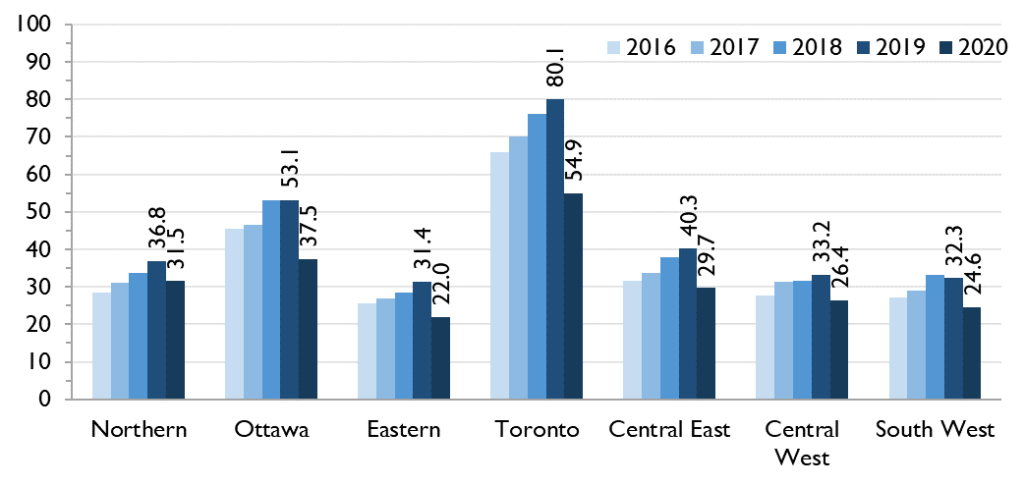
HIV tests down in all age groups, especially younger ones
The HIV test rate per 1,000 people decreased in all age groups in 2020 but particularly in younger people. Those aged 15-19 had the largest relative decrease (41%) in 2020 from 2019, and those aged 20-24 had the largest absolute decrease (from 96.2 per 1,000 people in 2019 to 63.9 per 1,000 people in 2020). This may suggest that younger people were less willing or able to seek out HIV testing as a result of the COVID pandemic.
Figure 2: Rate of HIV tests per 1,000 people, by age, Ontario, 2016 to 2020
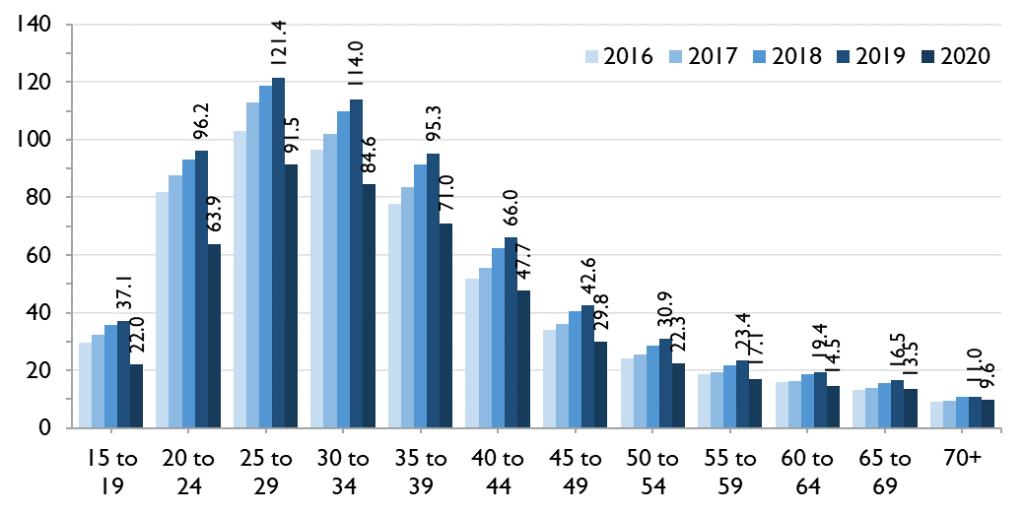
Anonymous testing down disproportionately
During 2020, testing was less available through many public health units and other programs that offer anonymous testing due to the COVID-19 response. As a result, the total number of anonymous HIV tests decreased dramatically from 16,478 in 2019 to 5,309 in 2020, and was down 68% in males and 67% in females. Anonymous tests accounted for only 1.1% of all HIV tests in 2020 compared to 2.4% in 2019.
Figure 3: Number of anonymous HIV tests, by sex, Ontario, 2011 to 2020

Test numbers and rates down, but test positivity rate consistent
While both the number of tests and the testing rate per 1,000 people decreased in 2020 in Ontario, the overall HIV test positivity rate remained the same as in 2019: 0.10% or one positive diagnosis for every 1,000 tests.
However, test positivity rates differed by sex. The positivity rate increased in males from 0.154% in 2019 to 0.169% in 2020 and decreased in females from 0.051% in 2019 to 0.042% in 2020. The higher positivity rate among males means that, despite the impact of COVID-19, males at high risk were still accessing testing. The lower positivity rate among females suggests that either women at risk were less likely to access HIV testing during COVID or there were fewer HIV infections among females in 2020. (See OHESI’s December 2021 blog post for a depiction of this [Figure 3])
It’s important to note that the positivity rate in males who tested anonymously increased from 0.54% in 2019 to 1.04% in 2020 (+92%): its highest level since 2011. This increase indicates that males at high risk accessed anonymous testing in 2020. None of the females who tested anonymously in 2020 were HIV positive.
Sexual health clinics/public health units and community health centres especially impacted by COVID-19
Numbers of HIV tests decreased from some HIV test submitter types more than others in 2020. The largest relative decreases were seen in sexual health clinics/public health units (PHUs, 56%), community health centres (43%), and other physicians/clinics/labs (31%). This was likely a consequence of closures related to COVID-19, and helps explain the decrease in overall HIV test numbers.
Figure 4a: Number of HIV tests, by HIV test submitter type, Ontario, 2019 to 2020
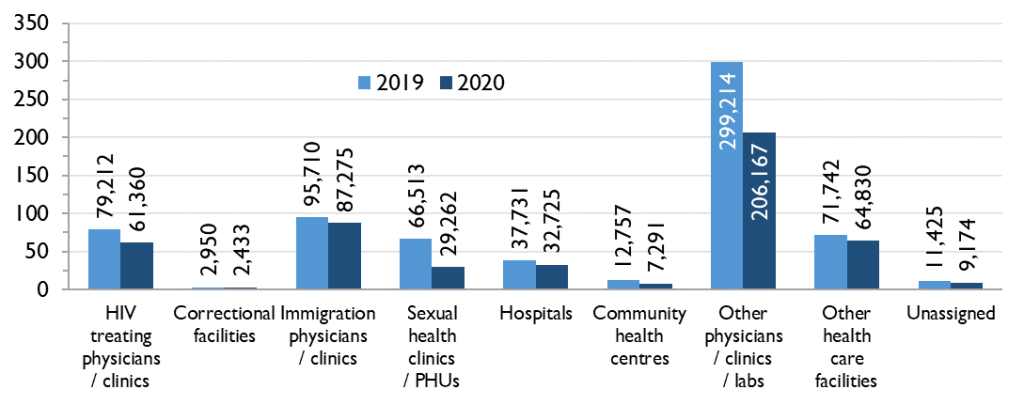
Numbers of positive results submitted by HIV treating physicians/clinics and hospitals remained stable in 2020, while decreases were seen from 2019 in community health centres (55% relative decrease), immigration physicians/clinics (48%), sexual health clinics/PHUs (39%), and other physicians/clinics/labs (22%). This suggests higher risk individuals may still have accessed HIV testing from HIV treating physicians/clinics and hospitals in 2020. It also reflects the reduced access to HIV testing at sexual health clinics/PHUs and community health centres in 2020 due to COVID-19.
Figure 4b: Number of positive results, by HIV test submitter type, Ontario, 2019 to 2020
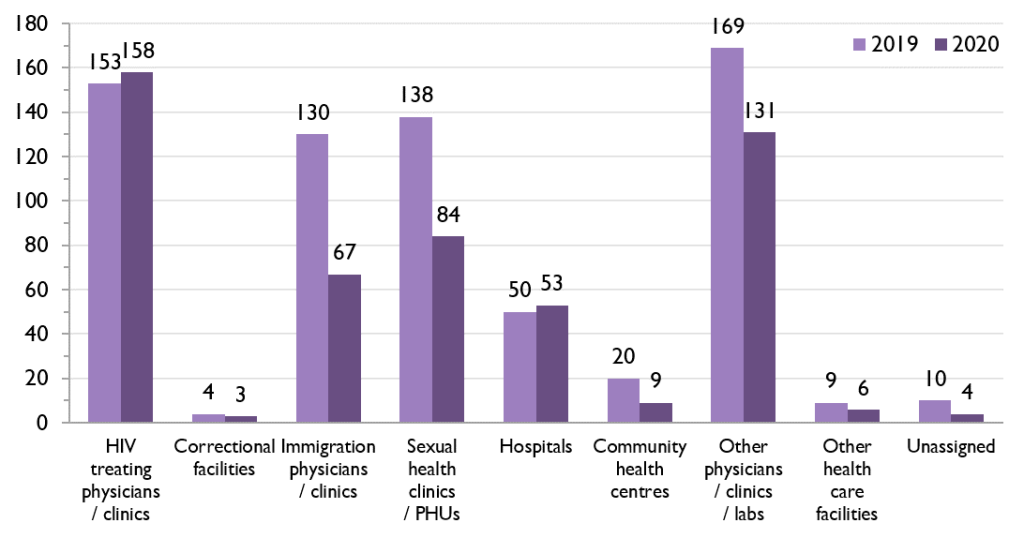
No HIV exposure category disproportionately affected by drop in HIV testing
Despite the decrease in HIV testing in 2020 from 2019, the distribution of people seeking testing across HIV exposure categories was similar to prior years. This trend indicates that the reduction in HIV tests in 2020 did not disproportionately affect any of the populations most at risk of HIV.
Figure 5: Percent of HIV tests by exposure category (where reported), Ontario, 2016 to 2020

For more information, see the full report here (link).
For a more detailed discussion of the impacts of the pandemic, see our blog post, Impact of COVID-19 Pandemic on HIV testing and diagnosis in Ontario.
Stay tuned for more OHESI reports coming soon!
OHESI is a collaboration involving AIDS and Hepatitis C Programs of the Ontario Ministry of Health, Public Health Ontario, the Public Health Agency of Canada, and the Ontario HIV Treatment Network. The objectives of OHESI are to analyze, monitor and disseminate knowledge products on the epidemiology of HIV in Ontario.

